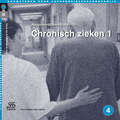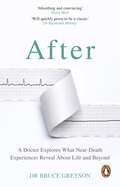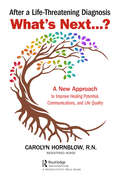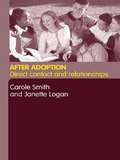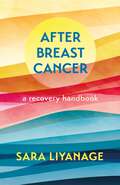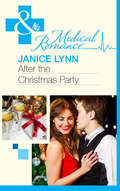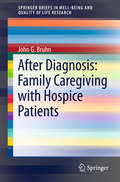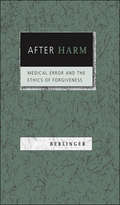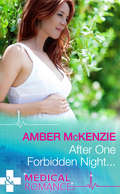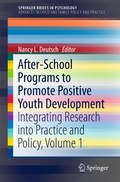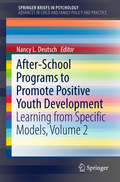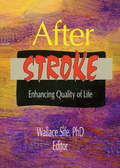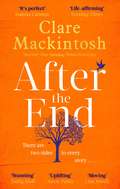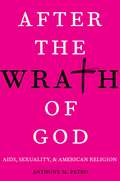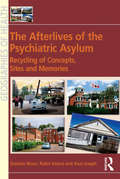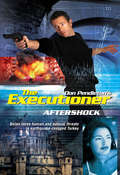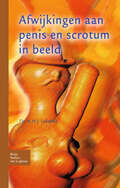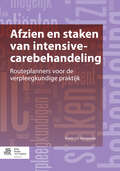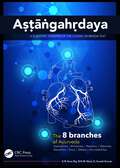- Table View
- List View
Afstudeerdifferentiatie 415 Chronisch zieken 1: Niveau 4
by J.M.F. van der Sluis-Houtkamp De Jong Consulting B.V. J.A.M. KerstensDifferentiatiekatern voor BOL- en BBL studenten die in de laatste fase zijn gekomen van de opleiding tot verpleegkundige niveau 4. Het katern is een hulpmiddel bij het afstuderen en reikt verschillende mogelijkheden voor binnen- en buitenschoolse verdieping aan. In de casuïstiek in dit katern komen de eindtermen van deelkwalificatie 415 meerdere malen op verschillende wijze aan bod. Gedurende de BPV toont de deelnemer dat hij/zij in staat is als verpleegkundige zorg te verlenen aan chronisch zieken (415.03). Het kunnen toepassen van GVO (415.04) wordt eveneens in de BPV getoond. Ook het kunnen coördineren van zorg bij chronisch zieken (415.05) wordt in de BPV getoond. De subeindtermen zijn vertaald in taken bij de casussen. Het bevorderen van kwaliteitszorg en deskundigheidsbevordering ten aanzien van chronisch zieken (415.06) wordt geleerd met behulp van projecttaken.
After: A Doctor Explores What Near-Death Experiences Reveal About Life and Beyond
by Dr. Bruce Greyson, MDThe world's leading expert on near-death experiences reveals his journey toward rethinking the nature of death, life, and the continuity of consciousness.What happens when we die? 10% of people whose hearts stop report near-death experiences (NDEs). Stories of lights, tunnels and loved ones have been relayed — and dismissed — since ancient times. But when Dr Bruce Greyson’s patients started describing events that he could not just dismiss, he began to investigate.As a physician without a religious belief system, he approached NDEs from a scientific perspective. In After, he shares the transformative lessons he has learned over four decades of research. Our culture has tended to view dying as the end of our consciousness, the end of our existence — a dreaded prospect that for many people evokes fear and anxiety.But Dr Greyson shows how scientific revelations about the dying process can support an alternative theory. Dying could be the threshold between one form of consciousness and another, not an ending but a transition. This new perspective on the nature of death can transform the fear of dying that pervades our culture into a healthy view of it as one more milestone in the course of our lives. After challenges us to reconsider these experiences and what they can teach us about the relationship between our brain and our mind, expanding our understanding of consciousness, and of what it means to be human.
After a Life-Threatening Diagnosis...What's Next?: A New Approach to Improve Healing Potential, Communications, and Life Quality
by Carolyn HornblowThis book should prove valuable in relieving stress and anxiety, especially important nowadays as the journey from diagnosis to cure or death is longer due to improvements in medical treatments. Healthcare workers and the general public worldwide would benefit as death is universal. The writing style is engaging and easy to read, yet highly informative. I would recommend this book to my patients and their families and friends. Dr. Suzanne Ward BMED FRAGP General Medical Practitioner Canberra, Australia This easy to read manual is invaluable reading following a life-threatening medical diagnosis. It is a comprehensive, clear and concise guide which can help reduce stress and improve healing potential. Written by a Registered Nurse (ret) who worked in the USA, UK, and Australia, she discusses why expressing fears soon after diagnosis can be beneficial for healing. Whatever the diagnosis, Cancer, Heart Attack, Stroke, Parkinson’s Disease, etc., you, your family, friends and colleagues will have worries and fears about your future. Reducing fears and stress early on gives more positive room for healing. This manual is indispensable for Doctors and Nurses, encouraging them to learn why and how discussing fears early on is a positive healing opportunity rather than being negative. Various complementary therapies are discussed to use in combination with traditional medicine, maximizing healing opportunities. While we plan for births and marriages, we find it difficult to talk and plan for our deaths, even though none of us escapes it! This book provides tools and suggestions for preparing Wills, Advanced Directives, and listing assets and wishes at whatever age, the sooner the better. Being prepared makes life so much easier for all. Learn how to live a more content, peaceful life alongside your family, friends, neighbors and globally. Life is not a dress rehearsal. Learn how to live fully NOW.
After a Life-Threatening Diagnosis...What's Next?: A New Approach to Improve Healing Potential, Communications, and Life Quality
by Carolyn HornblowThis book should prove valuable in relieving stress and anxiety, especially important nowadays as the journey from diagnosis to cure or death is longer due to improvements in medical treatments. Healthcare workers and the general public worldwide would benefit as death is universal. The writing style is engaging and easy to read, yet highly informative. I would recommend this book to my patients and their families and friends. Dr. Suzanne Ward BMED FRAGP General Medical Practitioner Canberra, Australia This easy to read manual is invaluable reading following a life-threatening medical diagnosis. It is a comprehensive, clear and concise guide which can help reduce stress and improve healing potential. Written by a Registered Nurse (ret) who worked in the USA, UK, and Australia, she discusses why expressing fears soon after diagnosis can be beneficial for healing. Whatever the diagnosis, Cancer, Heart Attack, Stroke, Parkinson’s Disease, etc., you, your family, friends and colleagues will have worries and fears about your future. Reducing fears and stress early on gives more positive room for healing. This manual is indispensable for Doctors and Nurses, encouraging them to learn why and how discussing fears early on is a positive healing opportunity rather than being negative. Various complementary therapies are discussed to use in combination with traditional medicine, maximizing healing opportunities. While we plan for births and marriages, we find it difficult to talk and plan for our deaths, even though none of us escapes it! This book provides tools and suggestions for preparing Wills, Advanced Directives, and listing assets and wishes at whatever age, the sooner the better. Being prepared makes life so much easier for all. Learn how to live a more content, peaceful life alongside your family, friends, neighbors and globally. Life is not a dress rehearsal. Learn how to live fully NOW.
After Adoption: Direct Contact and Relationships
by Janette Logan Carole SmithFew children nowadays are placed for adoption with no form of contact planned with birth relatives and it has become common professional practice to advocate direct rather than indirect contact. Practice has outstripped evidence in this respect and not enough is known about how contact arrangements actually work out, particularly for older children adopted from state care. Such children have often experienced neglect, and sometimes abuse, and have frequently been adopted without parental agreement. Based on research with a large number of adoptive parents, children and birth relatives, After Adoption considers the impact of direct post-adoption contact on all concerned in such cases. It also:· discusses the development of adoption policy and law, particularly with regard to the legal and social consequences · reviews the research evidence on adopted children's contact with their birth families· explores through interviews: participants' feelings about adoption and direct contact; their relationships with each other; what hinders and what helps.After Adoption challenges readers to re-think the relationship between adoption and the possibility of direct post-adoption contact and at the same time provides a comprehensive understanding of adoption issues. It is a timely and valuable addition to the literature on adoption, making a substantial contribution to policy and practice.
After Adoption: Direct Contact and Relationships
by Janette Logan Carole SmithFew children nowadays are placed for adoption with no form of contact planned with birth relatives and it has become common professional practice to advocate direct rather than indirect contact. Practice has outstripped evidence in this respect and not enough is known about how contact arrangements actually work out, particularly for older children adopted from state care. Such children have often experienced neglect, and sometimes abuse, and have frequently been adopted without parental agreement. Based on research with a large number of adoptive parents, children and birth relatives, After Adoption considers the impact of direct post-adoption contact on all concerned in such cases. It also:· discusses the development of adoption policy and law, particularly with regard to the legal and social consequences · reviews the research evidence on adopted children's contact with their birth families· explores through interviews: participants' feelings about adoption and direct contact; their relationships with each other; what hinders and what helps.After Adoption challenges readers to re-think the relationship between adoption and the possibility of direct post-adoption contact and at the same time provides a comprehensive understanding of adoption issues. It is a timely and valuable addition to the literature on adoption, making a substantial contribution to policy and practice.
After Breast Cancer: A Recovery Handbook
by Sara Liyanage'Once treatment stops, and people leave strictly managed clinical environments, survivors feel as though they had "fallen off a cliff edge"... feeling isolated and abandoned at a time when support is needed the most'. - Mental Health Foundation From the final infusion to the five-year check, After Breast Cancer gives a step-by-step support package to coping post-treatment. It follows on from Sara Liyanage's successful coverage of diagnosis and treatment in Ticking Off Breast Cancer, and is driven not only by her experience of illness, but underpinned by contributions from leading oncologists, heads of cancer services, and clinical consultant psychologists. With a readable blend of informality and medically endorsed insight, After Breast Cancer has an optimistic outlook and a reassuring tone, but doesn't flinch from discussing the possibility of secondary cancer, or the full impact of treatment and surgery on you or your loved one. It features a huge amount of practical information, including a full toolkit for navigating the days post-treatment - including breathing exercises, mindfulness meditation, journaling, affirmations and a healthy bedtime routine. Designed for women of all backgrounds, whatever the nature of their diagnosis, this blend of approachability, lived experience and medical insight puts the power firmly back in your hands, as a breast cancer survivor.
After The Christmas Party… (Mills And Boon Medical Ser.)
by Janice LynnNurse Trinity Warren is hiding in the corner at her office Christmas party and she’s miserable! Parties like this remind her of all the many heart-breaking reasons why she hates this time of year, so she’s only there under duress. Until Dr. Riley Williams, hospital heartthrob, asks her to dance and kisses her under the mistletoe!
After Diagnosis: Family Caregiving with Hospice Patients (SpringerBriefs in Well-Being and Quality of Life Research)
by John G. BruhnThis brief provides approaches to help family caregivers understand the role of caregiving, its challenges and consequences. Using real life case examples, it illustrates the essentials of family caregiving. The caregiving role can be a source of caregiver stress and can become increasingly burdensome. People are now living longer and acquiring chronic diseases, which makes it necessary to involve caregivers to assist in disability care for longer periods of time, and live out their end-time at home, which means caregivers are more and more needed, especially at the end-of-life. This brief illustrates the role and scope of caregiving and its future growth. It is useful to physicians, social workers, sociologists, psychologists, nurses, public health, public policy and families and has a broad appeal for use in courses on Death and Dying.
After Harm: Medical Error and the Ethics of Forgiveness
by Nancy BerlingerMedical error is a leading problem of health care in the United States. Each year, more patients die as a result of medical mistakes than are killed by motor vehicle accidents, breast cancer, or AIDS. While most government and regulatory efforts are directed toward reducing and preventing errors, the actions that should follow the injury or death of a patient are still hotly debated. According to Nancy Berlinger, conversations on patient safety are missing several important components: religious voices, traditions, and models. In After Harm, Berlinger draws on sources in theology, ethics, religion, and culture to create a practical and comprehensive approach to addressing the needs of patients, families, and clinicians affected by medical error. She emphasizes the importance of acknowledging fallibility, telling the truth, confronting feelings of guilt and shame, and providing just compensation. After Harm adds important human dimensions to an issue that has profound consequences for patients and health care providers.
After One Forbidden Night... (Mills And Boon Medical Ser.)
by Amber McKenzieThe cost of the forbidden…Successful ER physician Dr Chloe Darcy has her professional life all sewn up. Her love life is another matter! Being secretly in love with powerful, charismatic vascular surgeon Tate Reed is torture… As her best friend’s ex, he’s strictly off-limits!
After-School Programs to Promote Positive Youth Development: Integrating Research into Practice and Policy, Volume 1 (SpringerBriefs in Psychology)
by Nancy L. DeutschThe first volume of this SpringerBrief presents a series of papers compiled from a conference about how after-school programs may be implemented to promote positive youth development (PYD) hosted by Youth-Nex, the University of Virginia Center to Promote Effective Youth Development. This volume reviews the importance of after-school programs for PYD and discusses key components of effective after-school programs. It also discusses issues related to the evaluation and measurement of quality in after-school programs. In addition, the brief presents suggestions for how researchers, policy makers, and practitioners can move the field forward and maximize the potential of after-school time and programs for promoting positive youth development for children and adolescents. Topics featured in this brief include: The history of the relationship between after-school programs and positive youth development. Specific features of programs that are important for advancing positive youth development. Issues in and approaches to measuring quality in after-school programs.The Quality, Engagement, Skills, Transfer (QuEST) model and its use for measuring effective after-school programs. A case study evaluation of the Girls on the Run program. After-School Programs to Promote Positive Youth Development, Volume 1, is a must-have resource for policy makers and related professionals, graduate students, and researchers in child and school psychology, family studies, public health, social work, law/criminal justice, and sociology.
After-School Programs to Promote Positive Youth Development: Learning from Specific Models, Volume 2 (SpringerBriefs in Psychology)
by Nancy L. DeutschThe second volume of this SpringerBrief presents a series of papers compiled from a conference addressing how after-school programs can promote positive youth development (PYD) hosted by Youth-Nex, the University of Virginia Center to Promote Effective Youth Development. It examines summer learning and best practices for different types of after-school programs by drawing on the experiences of researchers, program staff, and youth participants. It also presents case studies of five specialized programs and discusses their strengths, limitations, and challenges. In addition, the brief offers recommendations drawn from across the two volumes for how researchers, policy makers, and practitioners can move the field forward and maximize the potential of after-school time and programs to promote positive youth development for children and adolescents. Featured case studies of specialized after-school programs include: Richmond, Virginia’s ROSMY.The Clubhouse: Where Technology Meets Imagination.The Young Women Leaders Program (YWLP).Whatever It Takes (WIT) Program.UTEC of Lowell, Massachusetts.After-School Programs to Promote Positive Youth Development, Volume 2, is a must-have resource for policy makers and related professionals, graduate students, and researchers in child and school psychology, family studies, public health, social work, law/criminal justice, and sociology.
After Stroke: Enhancing Quality of Life
by Wallace SifeAfter Stroke: Enhancing Quality of Life brings together an extraordinary selection of advice, practical survivor techniques, information about resources, and personal stories of triumph. It is designed to help those who have experienced a stroke attain the highest quality of life possible, under their new physical restrictions.Recuperating from a stroke is an arduous process that has only just begun when the survivor is released from the hospital. This book shows anyone interested how to create an effective climate for healing and how to help the survivor realize his/her fullest recovery potential. It offers varied perspectives of everyone involved with a stroke: the patient, the family, and friends as well as the team of specialized physicians, nurses, psychologists, physical therapists, speech pathologists, and diverse therapists.Through its interesting and varied essays, After Stroke: Enhancing the Quality of Life offers the reader a clearer understanding of the injuries that the body as well as the mind have sustained. This anthology is carefully designed to present enhanced perspectives into all aspects of the healing and recovery processes that follow the personal tragedy of a stroke.
After Stroke: Enhancing Quality of Life
by Wallace SifeAfter Stroke: Enhancing Quality of Life brings together an extraordinary selection of advice, practical survivor techniques, information about resources, and personal stories of triumph. It is designed to help those who have experienced a stroke attain the highest quality of life possible, under their new physical restrictions.Recuperating from a stroke is an arduous process that has only just begun when the survivor is released from the hospital. This book shows anyone interested how to create an effective climate for healing and how to help the survivor realize his/her fullest recovery potential. It offers varied perspectives of everyone involved with a stroke: the patient, the family, and friends as well as the team of specialized physicians, nurses, psychologists, physical therapists, speech pathologists, and diverse therapists.Through its interesting and varied essays, After Stroke: Enhancing the Quality of Life offers the reader a clearer understanding of the injuries that the body as well as the mind have sustained. This anthology is carefully designed to present enhanced perspectives into all aspects of the healing and recovery processes that follow the personal tragedy of a stroke.
After the End: The most moving book you'll read in 2019
by Clare MackintoshThe powerful and page-turning new novel from number one Sunday Times bestseller, Clare Mackintosh.'The most moving book you'll read this year' LISA JEWELL'Compelling and clever, tender and true. I can't stop thinking about it' LIANE MORIARTYMax and Pip are the strongest couple you know. Only now they're facing the most important decision of their lives - and they don't agree.As the consequences of an impossible choice threaten to devastate them both, nothing will ever be the same again.But anything can happen after the end . . . .____________________Everyone is talking about After the End:'This was a heart-breaking read and at times I forgot to breathe' 'If I could give this book 10 stars I would' 'This book touched my soul' 'I could not put it down. What a story. What a storyteller' 'This is in my top five books of all time. Absolutely incredible' 'I have never felt so emotionally wrapped up in characters in a book'
After the Wrath of God: AIDS, Sexuality, & American Religion
by Anthony M. PetroOn a cold February morning in 1987, amidst freezing rain and driving winds, a group of protesters stood outside of the Unitarian Universalist Church in Amherst, Massachusetts. The target of their protest was the minister inside, who was handing out condoms to his congregation while delivering a sermon about AIDS, dramatizing the need for the church to confront the seemingly ever-expanding crisis. The minister's words and actions were met with a standing ovation from the overflowing audience, but he could not linger to enjoy their applause. Having received threats in advance of the service, he dashed out of the sanctuary immediately upon finishing his sermon. Such was the climate for religious AIDS activism in the 1980s. In After the Wrath of God, Anthony Petro vividly narrates the religious history of AIDS in America. Delving into the culture wars over sex, morality, and the future of the American nation, he demonstrates how religious leaders and AIDS activists have shaped debates over sexual morality and public health from the 1980s to the present day. While most attention to religion and AIDS foregrounds the role of the Religious Right, Petro takes a much broader view, encompassing the range of mainline Protestant, evangelical, and Catholic groups--alongside AIDS activist organizations--that shaped public discussions of AIDS prevention and care in the U.S. Petro analyzes how the AIDS crisis prompted American Christians across denominations and political persuasions to speak publicly about sexuality--especially homosexuality--and to foster a moral discourse on sex that spoke not only to personal concerns but to anxieties about the health of the nation. He reveals how the epidemic increased efforts to advance a moral agenda regarding the health benefits of abstinence and monogamy, a legacy glimpsed as much in the traction gained by abstinence education campaigns as in the more recent cultural purchase of gay marriage. The first book to detail the history of religion and the AIDS epidemic in the U.S., After the Wrath of God is essential reading for anyone concerned with the intersection of religion and public health.
After the Wrath of God: AIDS, Sexuality, & American Religion
by Anthony M. PetroOn a cold February morning in 1987, amidst freezing rain and driving winds, a group of protesters stood outside of the Unitarian Universalist Church in Amherst, Massachusetts. The target of their protest was the minister inside, who was handing out condoms to his congregation while delivering a sermon about AIDS, dramatizing the need for the church to confront the seemingly ever-expanding crisis. The minister's words and actions were met with a standing ovation from the overflowing audience, but he could not linger to enjoy their applause. Having received threats in advance of the service, he dashed out of the sanctuary immediately upon finishing his sermon. Such was the climate for religious AIDS activism in the 1980s. In After the Wrath of God, Anthony Petro vividly narrates the religious history of AIDS in America. Delving into the culture wars over sex, morality, and the future of the American nation, he demonstrates how religious leaders and AIDS activists have shaped debates over sexual morality and public health from the 1980s to the present day. While most attention to religion and AIDS foregrounds the role of the Religious Right, Petro takes a much broader view, encompassing the range of mainline Protestant, evangelical, and Catholic groups--alongside AIDS activist organizations--that shaped public discussions of AIDS prevention and care in the U.S. Petro analyzes how the AIDS crisis prompted American Christians across denominations and political persuasions to speak publicly about sexuality--especially homosexuality--and to foster a moral discourse on sex that spoke not only to personal concerns but to anxieties about the health of the nation. He reveals how the epidemic increased efforts to advance a moral agenda regarding the health benefits of abstinence and monogamy, a legacy glimpsed as much in the traction gained by abstinence education campaigns as in the more recent cultural purchase of gay marriage. The first book to detail the history of religion and the AIDS epidemic in the U.S., After the Wrath of God is essential reading for anyone concerned with the intersection of religion and public health.
The Afterlives of the Psychiatric Asylum: Recycling Concepts, Sites and Memories (Geographies of Health Series)
by Graham Moon Robin KearnsThe last 40 years has seen a significant shift from state commitment to asylum-based mental health care to a mixed economy of care in a variety of locations. In the wake of this deinstitutionalisation, attention to date has focussed on users and providers of care. The consequences for the idea and fabric of the psychiatric asylum have remained 'stones unturned'. This book address an enduring yet under-examined question: what has become of the asylum? Focussing on the 'recycling' of both the idea of the psychiatric asylum and its sites, buildings and landscapes, this book makes theoretical connections to current trends in mental health care and to ideas in cultural/urban geography. The process of closing asylums and how asylums have survived in specific contexts and markets is assessed and consideration given to the enduring attraction of asylum and its repackaging as well as to retained mental health uses on former asylum sites, new uses on former sites, and interpretations of the derelict psychiatric asylum. The key questions examined are the challenges posed in seeking new uses for former asylums, the extent to which re-use can transcend stigma yet sustain memory and how location is critical in shaping the future of asylum and asylum sites.
The Afterlives of the Psychiatric Asylum: Recycling Concepts, Sites and Memories (Geographies of Health Series)
by Graham Moon Robin KearnsThe last 40 years has seen a significant shift from state commitment to asylum-based mental health care to a mixed economy of care in a variety of locations. In the wake of this deinstitutionalisation, attention to date has focussed on users and providers of care. The consequences for the idea and fabric of the psychiatric asylum have remained 'stones unturned'. This book address an enduring yet under-examined question: what has become of the asylum? Focussing on the 'recycling' of both the idea of the psychiatric asylum and its sites, buildings and landscapes, this book makes theoretical connections to current trends in mental health care and to ideas in cultural/urban geography. The process of closing asylums and how asylums have survived in specific contexts and markets is assessed and consideration given to the enduring attraction of asylum and its repackaging as well as to retained mental health uses on former asylum sites, new uses on former sites, and interpretations of the derelict psychiatric asylum. The key questions examined are the challenges posed in seeking new uses for former asylums, the extent to which re-use can transcend stigma yet sustain memory and how location is critical in shaping the future of asylum and asylum sites.
Aftershock
by Don PendletonSHOCK WAVE Mack Bolan is in Turkey to recover millions in stolen medical and relief supplies earmarked for displaced refugees in the civil-war-torn region. Racing to reclaim the cache before a violent insurgent group sells everything on the black market, Bolan finds his mission compromised when a massive earthquake rocks the region.
Afwijkingen aan penis en scrotum in beeld
by H. H. LeliefeldMet Afwijkingen aan penis en scrotum in beeld is er eindelijk een boek dat in beeld en tekst een moeilijk bespreekbaar onderwerp toegankelijk maakt. Immers, om urologische penoscrotale afwijkingen hangt nog steeds een onnodige en ongewenste taboesfeer die bovendien wordt versterkt door de irreële wereld van glossy-tijdschriften en reclame waarin alleen perfecte mensen lijken te bestaan. De schroom zit aan twee kanten. De patiënt denkt veelal - onterecht! - dat hij de enige is met zo´n afwijking. De niet-urologisch geschoolde arts heeft vaak te weinig ervaring met de fysische diagnostiek van urologische penoscrotale afwijkingen en slaat daardoor - net zo onterecht! - het penoscrotale gebied over bij lichamelijk onderzoek. Dit boek is een aansporing om bij lichamelijk onderzoek het penoscrotale gebied niet over te slaan, want er is vaak wel iets te vinden. Geïllustreerd met 100 afbeeldingen worden hier diverse "gewone", maar ook soms bizarre afwijkingen aan penis en scrotum getoond. Iedere urologische afwijking is voorzien van informatie aangaande diagnose, oorzaak, epidemiologie en therapie. Het maakt het boek buitengewoon waardevol voor gebruik in de dagelijkse praktijk van (huis)artsen, urologen en seksuologen. Ook voor studenten geneeskunde is dit boek een onmisbare bron van informatie.
Afzien en staken van intensive-carebehandeling: Routeplanners voor de verpleegkundige praktijk
by Erwin J.O. KompanjeIntensive care staat vooral bekend om het medisch-technisch handelen bij ernstig zieke patiënten. Dit hoogtechnologische handelen leidt helaas niet altijd tot genezing van de patiënt. De sterfte op een intensive care is, vergeleken met andere afdelingen in het ziekenhuis, dan ook hoog. Van alle patiënten die op een IC komen te overlijden, sterven in Nederland acht van de tien nadat besloten is dat verder behandelen niet meer in het belang van de patiënt is en de ingezette behandeling gestaakt wordt. Omdat de meeste patiënten bij wie de behandeling gestaakt wordt ernstig orgaanfalen hebben, kan dit aanleiding geven tot belastende symptomen zoals benauwdheid, reutelen, onrust, pijn en andere vormen van discomfort.Artsen en verpleegkundigen hebben de morele taak om deze symptomen zo goed mogelijk te behandelen teneinde de patiënt zo rustig mogelijk te kunnen laten overlijden. Beter is het om te anticiperen op mogelijk belastende symptomen. Helaas zijn veel artsen en verpleegkundigen onwennig in het geven van anticiperende palliatieve zorg op de IC. In dit boekje worden praktische routeplanners gegeven die artsen en verpleegkundigen op de IC stap voor stap kunnen helpen bij de zorg voor stervende patiënten op de IC.
Aṣṭāṅgahṛdaya: A Scientific Synopsis of the Classic Ayurveda Text
by G.R. Arun Raj N.K.M. Ikbal D. Suresh KumarWorldwide interest in Ayurveda is on the rise, ever since the World Health Organization adopted the Alma Ata Declaration in 1978. Ayurveda is increasingly being adopted and many phytotherapy schools in Europe and the Americas teach Ayurveda as a wellness system. Considering the prominent position that Aṣṭāṅgahṛdaya occupies in Ayurveda, a scientific synopsis of this masterpiece is now presented before the world of Ayurveda. In eight comprehensive chapters, Aṣṭāṅgahṛdaya: A Scientific Synopsis of the Classic Ayurveda Text presents a lucid summary of the teachings of Vāgbhaṭa. Ayurvedic view of the human body, basic principles of Ayurveda, surgical armamentarium, diagnosis and treatment of diseases, herbs and other medicinal substances used in the preparation of various dosage forms, ayurvedic pharmaceutialcs, ayurvedic approach to food fortification, salient features of Aṣṭāṅgahṛdaya and a roadmap for the future are among the topics discussed. Key Features: Presents the ayurvedic view of conception and the human body. Discusses aspects of ayurvedic pharmaceuticals. Examines diagnosis of diseases, lines of treatment, prognosis of diseases, signs of imminent death, management of mishaps and treatment of new diseases. The voluminous information pertaining to the subjects of the various chapters is presented in the form of many tables for ready reference and quick survey. This book provides a helping hand to those interested in rediscovering the teachings of Vāgbhaṭa and is a great resource for researchers of medicine, traditional and alternative medicine, pharmacology and drug discovery.
Aṣṭāṅgahṛdaya: A Scientific Synopsis of the Classic Ayurveda Text
by G.R. Arun Raj N.K.M. Ikbal D. Suresh KumarWorldwide interest in Ayurveda is on the rise, ever since the World Health Organization adopted the Alma Ata Declaration in 1978. Ayurveda is increasingly being adopted and many phytotherapy schools in Europe and the Americas teach Ayurveda as a wellness system. Considering the prominent position that Aṣṭāṅgahṛdaya occupies in Ayurveda, a scientific synopsis of this masterpiece is now presented before the world of Ayurveda. In eight comprehensive chapters, Aṣṭāṅgahṛdaya: A Scientific Synopsis of the Classic Ayurveda Text presents a lucid summary of the teachings of Vāgbhaṭa. Ayurvedic view of the human body, basic principles of Ayurveda, surgical armamentarium, diagnosis and treatment of diseases, herbs and other medicinal substances used in the preparation of various dosage forms, ayurvedic pharmaceutialcs, ayurvedic approach to food fortification, salient features of Aṣṭāṅgahṛdaya and a roadmap for the future are among the topics discussed. Key Features: Presents the ayurvedic view of conception and the human body. Discusses aspects of ayurvedic pharmaceuticals. Examines diagnosis of diseases, lines of treatment, prognosis of diseases, signs of imminent death, management of mishaps and treatment of new diseases. The voluminous information pertaining to the subjects of the various chapters is presented in the form of many tables for ready reference and quick survey. This book provides a helping hand to those interested in rediscovering the teachings of Vāgbhaṭa and is a great resource for researchers of medicine, traditional and alternative medicine, pharmacology and drug discovery.
